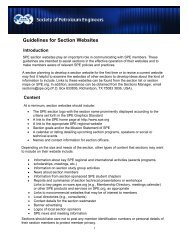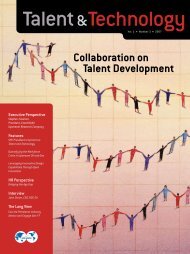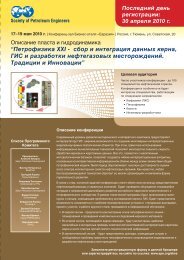Day 1 - Society of Petroleum Engineers
Day 1 - Society of Petroleum Engineers
Day 1 - Society of Petroleum Engineers
You also want an ePaper? Increase the reach of your titles
YUMPU automatically turns print PDFs into web optimized ePapers that Google loves.
16<br />
SPE TODAY<br />
City’s Art and History Mix Vibrantly, Providing Much to See<br />
Adam Wilson, SPE Today Editor<br />
Welcome to San Antonio, deep<br />
in the heart <strong>of</strong> Texas. Certainly,<br />
visiting a city for a convention doesn’t<br />
leave much time to explore; but, if<br />
you find yourself with time to venture<br />
outside <strong>of</strong> the convention, the city has<br />
many gems to be discovered. Because<br />
San Antonio is such a varied and vibrant<br />
city, the following is just a sample <strong>of</strong><br />
things to do while you’re in town if you<br />
have a bit more time. If nothing else,<br />
take time to stroll down the Riverwalk<br />
and mosey over to see the Alamo.<br />
Paseo del Rio<br />
The San Antonio River snakes through<br />
the heart <strong>of</strong> the city, cutting through<br />
the convention center where SPE’s<br />
Annual Technical Convention and<br />
Exhibition is being held. One floor<br />
below street level, the Riverwalk winds<br />
for approximately 5 miles, although<br />
an expansion project will extend the<br />
trail to 15 miles by 2013. The paths<br />
along the river connect the convention<br />
center and the Rivercenter Mall across<br />
the street to many <strong>of</strong> the area’s hotels,<br />
restaurants, and attractions.<br />
Open-air boats ferry people up and<br />
down the river, taking visitors on tours<br />
<strong>of</strong> the area and stopping along the way<br />
at restaurants, hotels, the convention<br />
center, and the mall. Some <strong>of</strong> these<br />
boats even double as places to dine. A<br />
boat tour costs USD 8.25 for general<br />
admission. The Rio Taxi service costs<br />
USD 5 one way or USD 10 for a 24-hour<br />
pass and USD 25 for a 3-day pass.<br />
Tour boats drift gently down the San Antonio River. A tour costs USD 8.25 per person. Credit: SACVB Photo/Al Rendon.<br />
Overview<br />
The Pearl Brewery originally opened<br />
as a brewery in 1881. It functioned as<br />
a brewery until 2001, when it began<br />
its transformation into the dining<br />
and shopping center it is today. The<br />
brewery is now home to several<br />
restaurant and shops, giving visitors a<br />
slice <strong>of</strong> San Antonio in one spot.<br />
If you’re looking for more than just<br />
a sample <strong>of</strong> the city, the Tower <strong>of</strong> the<br />
Americas can show you the whole<br />
enchilada. Rising 750 ft above the<br />
convention center, the tower provides<br />
full 360° view <strong>of</strong> the city. The Chart<br />
House restaurant sits at the top <strong>of</strong> the<br />
tower, slowly rotating so diners can<br />
see the whole city without leaving<br />
their tables. Tickets to the tower are<br />
USD 10.95 and include access to the<br />
observation deck.<br />
History and Heritage<br />
For those looking for an even broader<br />
view, The Institute <strong>of</strong> Texan Cultures<br />
showcases the diversity <strong>of</strong> culture<br />
in Texas. The museum, which is<br />
associated with the Smithsonian<br />
Institution, is just across the street<br />
from the Tower <strong>of</strong> the Americas. Built<br />
along with the tower for the 1968<br />
HemisFair, the museum now serves<br />
as Texas’ center for multicultural<br />
education, with exhibits designed to<br />
entertain and educate.<br />
San Antonio has plenty <strong>of</strong><br />
opportunities to get in touch with<br />
its Spanish history. The Spanish<br />
Governor’s Palace downtown near<br />
City Hall was the seat <strong>of</strong> government<br />
when San Antonio was the capital <strong>of</strong><br />
the Spanish Province <strong>of</strong> Texas. It is<br />
open to the public and is next to the<br />
A full moon shines over the Alamo, the most famous <strong>of</strong> San Antonio’s five<br />
missions and site <strong>of</strong> the Battle <strong>of</strong> the Alamo during the Texas Revolution.<br />
Credit: SACVB Photo.<br />
San Fernando Cathedral, which houses<br />
the nation’s oldest cathedral sanctuary;<br />
construction began in 1731.<br />
The city is also home to the Mission<br />
Trail, a route dotted with remnants<br />
<strong>of</strong> Spain’s conquest <strong>of</strong> the area. The<br />
first mission was constructed around<br />
1720. Ultimately, five missions were<br />
constructed, and they still stand as<br />
historical monuments. The missions are<br />
open for visits from 0900 to 1730 and<br />
give a glimpse <strong>of</strong> life when San Antonio<br />
was the frontier.<br />
The most famous <strong>of</strong> these missions<br />
is the Alamo, originally known as<br />
Mission San Antonio de Valero. The<br />
Alamo was the first mission established<br />
in San Antonio and was already 100<br />
years old when it fell during the<br />
Battle <strong>of</strong> the Alamo during the Texas<br />
Revolution in 1836. Approximately 200<br />
people, almost the entire population<br />
<strong>of</strong> the mission, died defending the<br />
mission against 1,500 Mexican troops<br />
during that battle. To this day, Texans<br />
remember the Alamo as a symbol <strong>of</strong><br />
struggle against insurmountable odds.<br />
While the Alamo is the most famous<br />
<strong>of</strong> San Antonio’s missions, Mission<br />
Concepcion has been called the most<br />
beautiful. Restoration and preservation<br />
efforts ensure the mission looks almost<br />
as it did more than 200 years ago.<br />
More remote than its sister<br />
missions, Mission Espada houses the<br />
best-preserved part <strong>of</strong> the medieval<br />
irrigation system used to water the<br />
fields. Parts <strong>of</strong> the system remain in<br />
use today.<br />
Mission San Jose and Mission<br />
San Juan complete the collection <strong>of</strong><br />
missions in and around San Antonio.<br />
San Jose was established in 1720 and<br />
has been called Queen <strong>of</strong> the Missions<br />
because <strong>of</strong> its grand stone walls,<br />
bastions, and church. San Juan has a<br />
still-functioning, open bell tower and<br />
includes a self-guided nature trail.<br />
The Art <strong>of</strong> Texas<br />
The San Antonio Museum <strong>of</strong> Art<br />
is down the Riverwalk from the<br />
convention center at Jones Avenue.<br />
The museum is closed on Mondays<br />
but is free on Tuesdays from 1600 to<br />
2100. Current exhibitions are “Rostros<br />
de Maria: The Virgin as Archetype<br />
and Inspiration,” a look at how the<br />
Virgin Mary has been portrayed in<br />
art throughout the centuries; “Adad<br />
Hannah: Intimate Encounters,” staged<br />
photographs and video tableaux that<br />
reinterpret historical art masterpieces;<br />
“Love in Three Capitals,” prints from<br />
the late 17th and early 18th centuries<br />
that portray life in the three capitals<br />
<strong>of</strong> Japan—Edo, Osaka, and Kyoto; and<br />
“Aphrodite and the Gods <strong>of</strong> Love,” a<br />
collection <strong>of</strong> ancient Greek statues<br />
and other representations centered<br />
on Aphrodite.<br />
The city also is dotted with eclectic<br />
art districts. La Villita and Market<br />
Square are two great collections <strong>of</strong> art<br />
and culture. La Villita, “the little village,”<br />
was one <strong>of</strong> San Antonio’s original<br />
settlements, developed in the late 18th<br />
century. Now, it is a haven for artists<br />
and craftsmen selling jewelry, stained<br />
glass, and other handcrafts, as well as<br />
fashions from Mexico and Guatemala.<br />
Dating to 1840, Market Square (El<br />
Mercado) is the largest Mexican<br />
marketplace north <strong>of</strong> the Rio Grande<br />
and a great place to find mementos <strong>of</strong><br />
your visit to the Lone Star State.
















